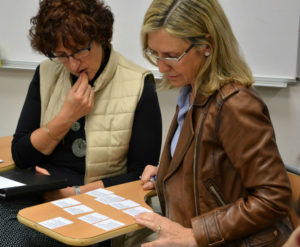Technology in the classroom
In-house teacher training
This course is also available online
1 week
Course Length
Flexible
Lesson Days
15
Lessons
English
Language
B1
Minimum Level
Overview
Technology can be a very useful tool in the classroom, not as an end in itself, but as a means for helping students to make better progress. You will be introduced to a range of technologies to enhance teaching and learning, including a number of highly accessible and free apps for use on smartphones and tablets. The course will let you enhance the imagination, creativity, innovation and digital wisdom of your students.
During the course, you will learn to match specific pedagogical challenges or opportunities with capabilities of various digital technologies to design new learning experiences. In addition, you will learn the different examples and uses of digital learning technologies in the classroom. The course content includes models for thoughtfully integrating pedagogy and technology, examples of innovative use of digital learning tools and environments, and professional support and resources to develop digital media and other learning content.
Completing this course will help you:
- Integrate different models of technology and pedagogy technique in your classroom
- Design, develop and implement a learning solution by integrating technologies into your lessons plans.
Who is the course for?
For teachers who want to acquire knowledge of processing information in order to improve teaching in the class by using the technology.
Course Sample programme
| Week 1 | Course Content |
| Day One | Introducing to a range of technologies to enhance teaching |
| Day Two | Integrate different models of technology and pedagogy technique in your classroom |
| Day Three | Examples of innovative use of digital learning tools |
| Day Four | Design, develop and implement a learning solution by integrating technologies into your lessons plans |
| Day Five | Review and Feedback |
*Please note that the course content may be subject to change due to latest methodology trends updates. 1 lesson=45mins
Share This Class:
What people are saying



In-House Training
You might also be interested in these courses

Supporting pupils with Special Educational Needs and Disabilities
This course develops the skills of those involved in the education of pupils with Special Educational Needs and/or Disabilities (SEND) so that these children…

Higher Order Thinking
Developing Higher Order Thinking requires teachers to establish with their student a knowledge base of thinking skills, reasoning, critical thought, and problem-solving…

Scaffolding
With our workshop “Scaffolding” you will understand in more details on how to support second language learners by providing helpful hints to help students…
More Courses in the UK, Ireland and Malta
You might also be interested in these courses

Technology for Language Teachers
Technology for Language teachers is aimed at teachers who want to use more technology in the classroom to enhance the learning experience of their students…

Teaching for Exam Classes
Teaching for Exam Classes is for English teachers who are preparing teenage or adult students for exams. Preparing to teach Cambridge or IELTS exam class. London…

Pronunciation and Performance with an expert “Adrian Underhill”
Pronunciation and Performance with an expert is a course led by a world-renowned ELT Consultant and Trainer. Adrian Underhill is an author and the series…
Methodologies

Total Physical Response
Total Physical Response is considered to be an excellent way of learning vocabulary. Moreover, since it is based on commands, the students can easily learn the meaning of the words in the target language.

The Structural Approach
This method is based on the opinion that it is imperative to understand the structures of the language. Understanding the complexities of the structures of the sentences in a language is more important than learning the vocabulary of the language.

The Direct Method
This method primarily focuses on the development of oral skills. One of the most important characteristic feature of this method is that visual materials and real-life objects are used. Moreover, such an oral training helps in reading and writing. There is no translation involved in this method.
